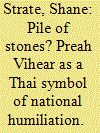| Srl | Item |
| 1 |
ID:
142850


|
|
|
|
|
| Summary/Abstract |
For the past three decades, nationalism has been a topic of great interest among scholars in the field of Thai Studies. Most of these scholars have, however, neglected the issue of gender in their examination of Thai nationalism. This article addresses this oversight by examining Thawiphop (Two Worlds) and Khu kam (Sunset on the Chao Phraya), two of the most popular novels by Thommayanti. As a well known nationalist and self-proclaimed feminist, Thommayanti has united the topics of gender and nationalism in these two works by representing female protagonists who strive to play an active role in the nationalist effort. Close examination reveals, however, that the nationalism of both protagonists is based on the psychoanalytic structure of the family romance that ultimately leads to a subversion of their agency. Thus, despite Thommayanti's attempt to depict strong and independent women in her novels, her characters ultimately fall short of transcending their subordinate roles in the discourse of nationalism.
|
|
|
|
|
|
|
|
|
|
|
|
|
|
|
|
| 2 |
ID:
120005


|
|
|
|
|
| Publication |
2013.
|
| Summary/Abstract |
The most recent border tensions between Thailand and Cambodia represent only the latest round of conflict over the status of Preah Vihear (Thai: Phra Viharn). This article uses newspaper and archival material to explore the modern history of the temple, largely from the Thai perspective, and focuses on how Preah Vihear has become the centrepiece of a Thai discourse on National Humiliation. Beginning with Prime Minister Phibun Songkhram's irredentist campaign of 1940, the Thai have associated these ancient ruins with the legacy of Western imperialism, particularly the territory 'lost' to French Indochina. For Thai nationalists, the 1962 international court case that awarded sovereignty over the temple site to Cambodia is an example of neo-imperialism that is part of this legacy. Thai media coverage of the court case compared the Preah Vihear situation with past defeats, including the loss of the four provinces in 1946 and the Franco-Siamese crisis of 1893. Conversely, Sihanouk and Cambodian leaders constructed a counter-narrative that compared Thai claims to Preah Vihear with the long history of Siamese imperialism in the region. It is Preah Vihear's centrality in National Humiliation discourse, rather than its religious or architectural significance, which makes it a powerful icon.
|
|
|
|
|
|
|
|
|
|
|
|
|
|
|
|